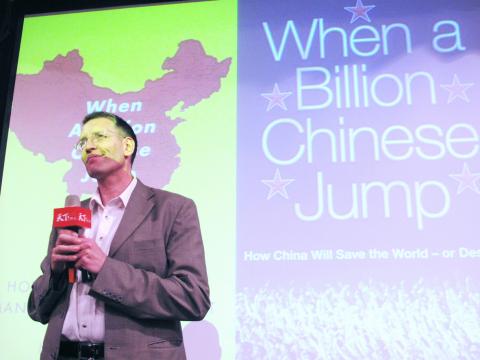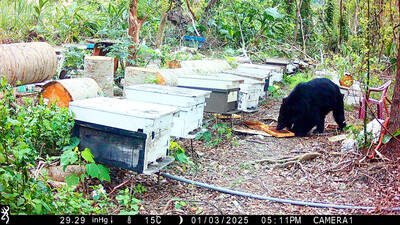That China’s ecosystems are in peril is not breaking news, but the speed of deterioration and the slow pace of attempts at recovery and clean up can shock even watchdogs monitoring the toll of the country’s economic boom. That’s where Taiwan comes in, a British reporter said.
In his new book When a Billion Chinese Jump, Jonathan Watts, Asia environment correspondent for the Guardian newspaper, takes readers deep into China’s environmental abyss. The industrial giant’s sprint up the economic ladder is being made at the expense not only of its ecosystems and climate, but also of the health of its citizens — the very workforce China so desperately needs to power its annual double-digit growth.
‘CANCER VILLAGES’

Photo: CNA
Regarding the phenomenon of so-called “cancer villages,” with about 100 to 400 spread throughout China, Watts said the disproportional rates of disease among the residents were most likely caused by toxic-waste discharges from nearby chemical factories.
“The fear of a Red China is outdated, but the hope of a green China is premature,” the investigative journalist, who has been based in China for the last seven years, said at a lecture in Taipei on Thursday last week.
“If there is any color to describe China now, it would be gray,” he said.
While China’s industrial explosion has been the envy of many other countries, it is teetering on the edge of both environmental and social implosions, Watts said, giving examples of disappearing species and riotous protests from angry villagers.
Being a late bloomer in terms of its economic development, China is deprived of the option of “outsourcing” its waste as was enjoyed by the UK, the US, Japan and other countries in their takeoff phases. Beijing is therefore forced to “in-source” its garbage, he said.
The bite marks resulting from China eating itself from the inside-out could be best illustrated by the wrong hues seen around the country, Watts said, citing examples of once-green paddy fields that are now yellow, blue rivers that have turned crimson and crystal white glaciers that used to be feared and revered, but are now brown and balding.
Pollution-induced human suffering is another bleak picture in China, Watts said.
In the coal town of Linfen, Shanxi Province, visited by Watts during the research for his book, the birth-defect rate is more than three times the global average, and the death rate of local miners per tonne of coal extracted is 30 times higher than that of their US counterparts.
However, while China’s eco-crisis might be more devastating than most people realize, Beijing’s determination to go green is also much greater than the outside world gives it credit for, he said.
As evidence, he said the Chinese government invested US$34 billion in clean technology last year, a figure that compared favorably with the US$18 billion spent by Washington.
China also has the world’s largest wind-power capacity, and its solar-panel industry is expanding rapidly, he said.
SOCIAL VALUES
However, a top-down strategy led by government policy would be incapable of solving China’s graying problem, and the solution must come from the grassroots level, Watts said.
This would require a complete overhaul of social values of consumption and conservation among the general public.
In fact, Beijing could look to Taiwan as an example of a success story in which both citizens and government officials have an awareness of global warming and the dire need for clean alternative energy.
Watts said that while interviewing Taiwanese officials last year in the aftermath of Typhoon Morakot, many acknowledged the unprecedented rainfall that left more than 700 dead or missing was likely a result of climate change and that the country needed to accelerate its defenses against extreme weather in the future.
Although Taiwan’s carbon footprint per person is “very high” and more should be done to reduce its carbon dioxide emissions, Watts said he was “extremely impressed” by Taipei City’s recycling program.
“I think it is a good model for China. The recycling situation in China is appalling, frankly. There is so much waste and it is not used properly. In a sense, it is not about techniques, but about the values — wanting to recycle used things, and I think that [awareness] is stronger here and can be carried over to the mainland,” he said.
Watts added that multinational conglomerates, including China-based Taiwanese companies, could contribute by cleaning up their supply chains and increasing their efforts to amplify environmental protection as part of their corporate social responsibility.
“In the 19th century, my country, Britain, taught the world how to produce. In the 20th century, the US taught the world how to consume. And I think in the 21st century, we really need China to teach us how to sustain,” he said.

SHIPS, TRAINS AND AUTOMOBILES: The ministry has announced changes to varied transportation industries taking effect soon, with a number of effects for passengers Beginning next month, the post office is canceling signature upon delivery and written inquiry services for international registered small packets in accordance with the new policy of the Universal Postal Union, the Ministry of Transportation and Communications said yesterday. The new policy does not apply to packets that are to be delivered to China, the ministry said. Senders of international registered small packets would receive a NT$10 rebate on postage if the packets are sent from Jan. 1 to March 31, it added. The ministry said that three other policies are also scheduled to take effect next month. International cruise ship operators

NUMBERS IMBALANCE: More than 4 million Taiwanese have visited China this year, while only about half a million Chinese have visited here Beijing has yet to respond to Taiwan’s requests for negotiation over matters related to the recovery of cross-strait tourism, the Tourism Administration said yesterday. Taiwan’s tourism authority issued the statement after Chinese-language daily the China Times reported yesterday that the government’s policy of banning group tours to China does not stop Taiwanese from visiting the country. As of October, more than 4.2 million had traveled to China this year, exceeding last year. Beijing estimated the number of Taiwanese tourists in China could reach 4.5 million this year. By contrast, only 500,000 Chinese tourists are expected in Taiwan, the report said. The report

The Forestry and Nature Conservation Agency yesterday launched a gift box to market honey “certified by a Formosan black bear” in appreciation of a beekeeper’s amicable interaction with a honey-thieving bear. Beekeeper Chih Ming-chen (池明鎮) in January inspected his bee farm in Hualien County’s Jhuosi Township (卓溪) and found that more than 20 beehives had been destroyed and many hives were eaten, with bear droppings and paw prints near the destroyed hives, the agency said. Chih returned to the farm to move the remaining beehives away that evening when he encountered a Formosan black bear only 20m away, the agency said. The bear

Chinese embassy staffers attempted to interrupt an award ceremony of an international tea competition in France when the organizer introduced Taiwan and displayed the Republic of China flag, a Taiwanese tea farmer said in an interview published today. Hsieh Chung-lin (謝忠霖), chief executive of Juxin Tea Factory from Taichung's Lishan (梨山) area, on Dec. 2 attended the Teas of the World International Contest held at the Peruvian embassy in Paris. Hsieh was awarded a special prize for his Huagang Snow Source Tea by the nonprofit Agency for the Valorization of Agricultural Products (AVPA). During the ceremony, two Chinese embassy staffers in attendance